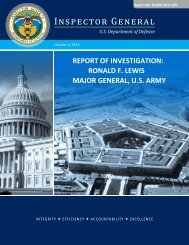Command Red Team
2gWzzvB
2gWzzvB
You also want an ePaper? Increase the reach of your titles
YUMPU automatically turns print PDFs into web optimized ePapers that Google loves.
<strong>Red</strong> <strong>Team</strong> Challenges<br />
of stepping away and holistically assessing the problem and independently developing its<br />
own set of evidence, assumptions, and conclusions.<br />
(11) Hidden Assumptions. All analysts and planners base their thinking on<br />
hidden assumptions, historical analogies, and paradigms that exist below the level of<br />
conscious thought. In many cases, these cognitive foundations are never tested for<br />
validity or relevance. Hidden assumptions can introduce unintended bias into analytical<br />
efforts. In addition, individuals who are unaware of their hidden assumptions may<br />
overlook or deny new information that should prompt a reassessment of their analytical<br />
foundations. The red team’s outside vantage point can help it identify implicit<br />
assumptions that others may not be aware of and suggest they be made explicit and<br />
systematically examined.<br />
(12) Assuming Away the Problem. When evaluating some problem sets,<br />
planners and analysts may adopt assumptions, or problem framing, that make the problem<br />
“solvable.” One red team role is to remind staff that some assumptions, however<br />
convenient, may actually be invalid, and some problem sets actually may not be solved<br />
without first changing conditions and allocating additional assets.<br />
(13) Overly Confident or Overly Pessimistic. Some problem-solving efforts<br />
may begin with the presumption that success, or failure, is the preordained outcome.<br />
Previous experience with the problem at hand can condition analysts, planners, and<br />
decision makers to anticipate one outcome or the other, and to interpret information and<br />
assessments in this light. The red team can counter such mindsets by suggesting<br />
historical analogies and using actual historical examples to broaden thinking and<br />
challenge the use of false analogies through alternative analysis and historical precedent.<br />
(14) Failure to Make the Call. Understanding the OE is often more dependent<br />
on the quality of analysis than the volume of information on hand. Past a certain point,<br />
additional information may improve confidence in an assessment without actually<br />
improving the accuracy of the assessment. When analysts and decision-makers hesitate<br />
to draw definitive conclusions based on available information, the red team may circulate<br />
its own independent assessment, based on informed speculation, to re-energize the<br />
analytical effort. By attacking the red team’s speculative strawman, the staff essentially<br />
uses the information it has on hand to test hypotheses and draw conclusions.<br />
(15) Elegance vice Insight. Persuasive arguments and repetition of<br />
conventional wisdom can, in some venues, be more convincing than reasoned analysis.<br />
An eloquent or dominating individual may be able to use persuasive rhetorical arguments<br />
or force of personality as a substitute for reasoned analysis, swaying others to bypass<br />
regular processes and adopt the individual’s position. <strong>Red</strong> teams should be prepared to<br />
use contrarian techniques to counter the human tendency to assume well-expressed<br />
conclusions are based on strong analysis.<br />
III-5



